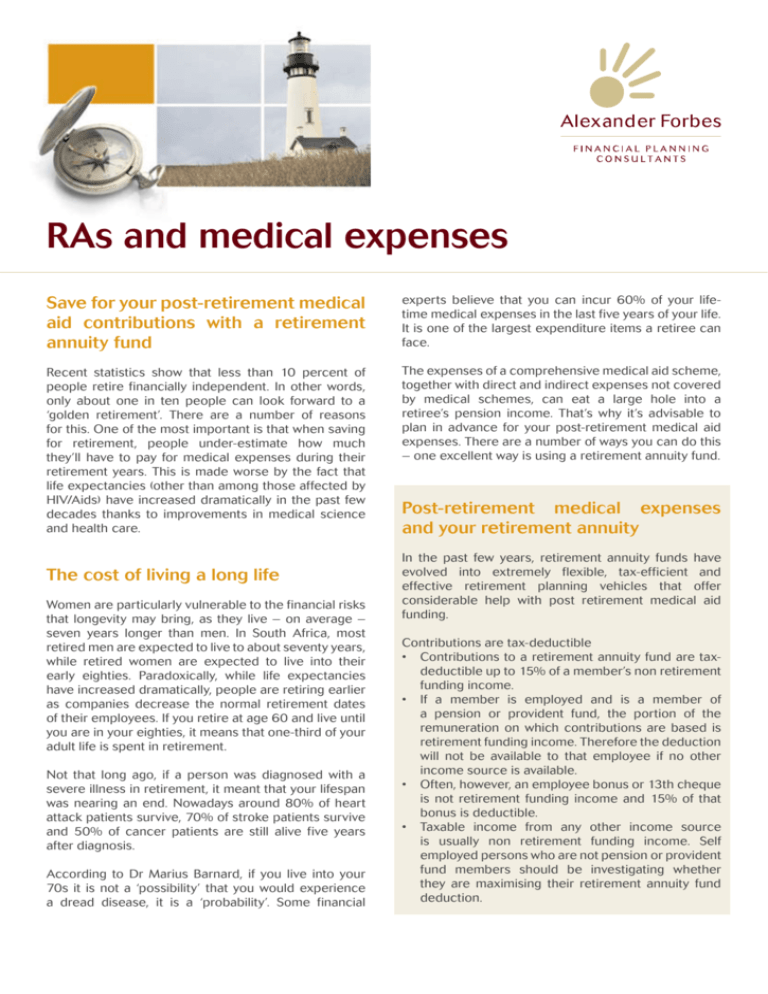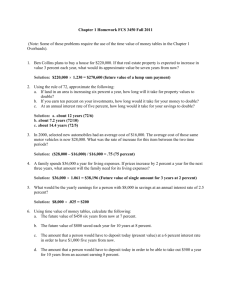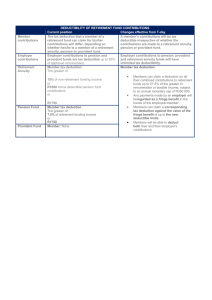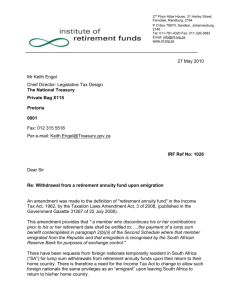RAs and medical expenses
advertisement

RAs and medical expenses Save for your post-retirement medical aid contributions with a retirement annuity fund experts believe that you can incur 60% of your lifetime medical expenses in the last five years of your life. It is one of the largest expenditure items a retiree can face. Recent statistics show that less than 10 percent of people retire financially independent. In other words, only about one in ten people can look forward to a ‘golden retirement’. There are a number of reasons for this. One of the most important is that when saving for retirement, people under-estimate how much they’ll have to pay for medical expenses during their retirement years. This is made worse by the fact that life expectancies (other than among those affected by HIV/Aids) have increased dramatically in the past few decades thanks to improvements in medical science and health care. The expenses of a comprehensive medical aid scheme, together with direct and indirect expenses not covered by medical schemes, can eat a large hole into a retiree’s pension income. That’s why it’s advisable to plan in advance for your post-retirement medical aid expenses. There are a number of ways you can do this – one excellent way is using a retirement annuity fund. The cost of living a long life Women are particularly vulnerable to the financial risks that longevity may bring, as they live – on average – seven years longer than men. In South Africa, most retired men are expected to live to about seventy years, while retired women are expected to live into their early eighties. Paradoxically, while life expectancies have increased dramatically, people are retiring earlier as companies decrease the normal retirement dates of their employees. If you retire at age 60 and live until you are in your eighties, it means that one-third of your adult life is spent in retirement. Not that long ago, if a person was diagnosed with a severe illness in retirement, it meant that your lifespan was nearing an end. Nowadays around 80% of heart attack patients survive, 70% of stroke patients survive and 50% of cancer patients are still alive five years after diagnosis. According to Dr Marius Barnard, if you live into your 70s it is not a ‘possibility’ that you would experience a dread disease, it is a ‘probability’. Some financial Post-retirement medical expenses and your retirement annuity In the past few years, retirement annuity funds have evolved into extremely flexible, tax-efficient and effective retirement planning vehicles that offer considerable help with post retirement medical aid funding. Contributions are tax-deductible • Contributions to a retirement annuity fund are taxdeductible up to 15% of a member’s non retirement funding income. • If a member is employed and is a member of a pension or provident fund, the portion of the remuneration on which contributions are based is retirement funding income. Therefore the deduction will not be available to that employee if no other income source is available. • Often, however, an employee bonus or 13th cheque is not retirement funding income and 15% of that bonus is deductible. • Taxable income from any other income source is usually non retirement funding income. Self employed persons who are not pension or provident fund members should be investigating whether they are maximising their retirement annuity fund deduction. Growth on investments within the RAF is tax-free • Investors in a retirement fund annuity can invest in a wide range of portfolios including equities, bonds, property and cash. Any interest, dividends and capital gains tax earned on these investments is tax-free in the fund. This provides the potential of an enhanced level of growth on retirement annuity fund contributions. Buying an annuity at retirement • Although up to one-third of the retirement benefit can be taken as a lump sum, the low tax concessions available on lump sums up to R900 000 will usually have already been used when retiring from pension or provident funds. Higher amounts are taxed at 36%. Therefore when funding for medical expenditure, an annuity is used to take advantages of the tax framework that exists. • Although an annuity is fully taxable in the hands of the annuitant, at age 65 or later, all medical expenditure including medical aid scheme contributions are fully tax-deductible. The new flexibility of retirement annuity funds allows a person to retire from the retirement annuity any time after age 55 – you no longer have to exit by age 70. Therefore you can continue funding the retirement annuity fund until you need the income. • Therefore, at age 65, you could retire from your retirement annuity fund and buy a compulsory annuity (monthly pension). If you buy a living annuity, you can choose to release an amount of between 2.5% and 175% of the capital value each year. This can be calculated in line with the medical aid scheme contribution for that year and paid directly to the medical aid scheme. • Although the annuity is fully taxable in the annuitant’s hands, this is set off against the deduction for medical expenditure allowed to retirees at age 65. Copyright in this material is expressly reserved and remains the exclusive property of Alexander Forbes Financial Services. This document and any attachments may not be altered, copied, stored, retrieved or in any way reproduced without the express written permission of Alexander Forbes Financial Services. Breach of copyright is a serious offence and can lead to litigation. Alexander Forbes Financial Planning Consultants (Proprietary) Limited (Registration Number: 1995/012764/07), FAIS Licence No. 31753. Alexander Forbes Individual Client Administration (Proprietary) Limited (Registration Number: 2007/015632/07, FAIS Licence No. 32494. The net effect A member’s post retirement medical aid liability for the period during which the capital of the retirement annuity fund lasts has been constructed using an unbroken trail of tax-free funding, namely: • Tax-deductible contributions • Tax-free growth within the fund • Taxable annuity stream which is offset by fully taxdeductible contributions at age 65. Take advantage of the tax break When considering your post retirement medical aid requirements, why not consult your financial adviser to assess whether you are on track with funding your post retirement medical expenses, and whether a retirement annuity fund could be appropriate? Taxpayers have until 28 February 2011 to take advantage of the tax concession for the 2010/11 tax year. Source: Jenny Gordon, Alexander Forbes Legal Services






